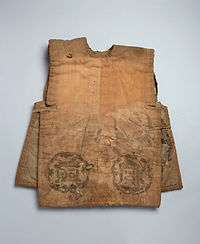Myeonje baegab


| Myeonje baegab | |
| Hangul | 면제배갑 |
|---|---|
| Hanja | 綿製背甲 |
| Revised Romanization | Myeonje Baegap |
| McCune–Reischauer | Myŏnje Paegap |
Myeonje Baegab (면제배갑, 綿製背甲) was a soft bullet-proof vest,[1] invented in the late 1860s in the Joseon Dynasty, modern day Republic of Korea.
It was invented following the French Campaign against Korea, 1866 and used in battle during the United States expedition to Korea in 1871. It was made of between 13 and 30 folds of cotton fabric and covered the upper torso.
Background
During the French Campaign against Korea, 1866, the military of the Joseon Kingdom, at the time using matchlock muskets, experienced the superiority of western rifles. As a result, Heungseon Daewongun, then acting leader of the Joseon Kingdom, ordered the development of bullet-proof armor.
The vests were distributed to soldiers after its creation, and were used in battles fought on Ganghwa Island against United States Navy and Marine forces during the United States expedition to Korea in 1871.
During the battle, the vests were proven to be bullet proof. However, they were easily burnt by fragments from cannon fire; US records indicate that some Korean soldiers caught fire after a cannon attack. Also, the vests were too hot to wear in summer.
The US army captured one of the vests and took it to the US. The vest was stored in the Smithsonian Museum until 2007. The vest has since been sent back to Korea and is currently on display to the public.[2]
Notes
External links
- 수자기 특별전
- 어재연 장군 '수자기' 136년 만의 귀환 특별전, 조선일보
- 특별전『수자기(帥字旗) - 136년 만의 귀환』, 고궁박물관
- 면 30겹 옷으로 대포에 맞선 강화도 조선군 <동아일보>